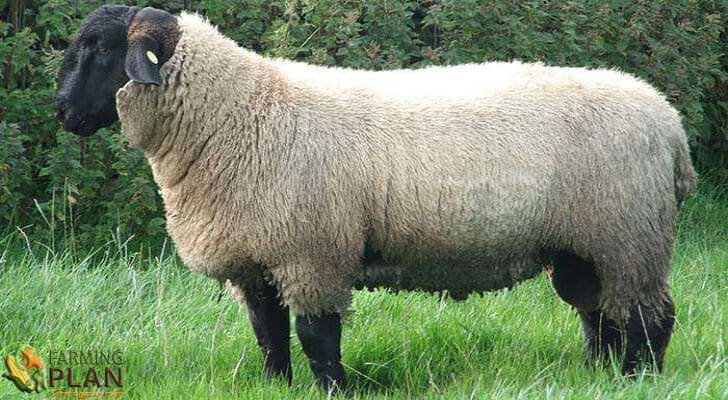The Suffolk sheep is native to England with a black face and dual ability. This means that this breed is produced for its meat and its wool. The black-faced breed originated by cross-breeding black-faced South Down sheep on ancient native sheep named Norfolk. It takes its name from the county of Suffolk, although it developed in the counties of Suffolk, Essex, and Norfolk in the southeast of England. The breed expanded rapidly, with the first herd in Ireland in the late 1800s.
For many centuries, sheep can export to the whole world, there are several countries where can breed this species. Such as Austria, France, Germany, Switzerland, Russia, North and South America and the colonies. Due to the meat requirements of the country and the precarious state of the Merino herds, at the end of the 19th century began to import Suffolk specimens to cross them with the Merinos. The results were not successful as the poor situation persisted.

Characteristics of Suffolk Sheep
The Suffolk sheep have black faces, ears, and limbs. The head and ears are completely free of wool, replacing them with fine hairs, which extend to a line behind the base of the ears. There is no wool under the knees and the Garrone. It is an agile animal and Walker. The Rams are in the range of 110 to 160 kilos of weight; in females varies from 80 to 110 kilos.
Its main qualities are meat and a good speed of growth. It is precocious, with easy deliveries when crossing with other races. Meat lambs are about 90 or 100 days old. They weigh from 35 to 40 kilos and have excellent conformation. The very young flesh is clear and tender.
They have adaptability and are perfectly suitable for crossings. This species produces very young flesh and is clear and tender. It is an ovine of great size, of muscular formation, of a long and tall body. You May Also Like To Read White Polled Heath Sheep.
It has fleece of white wool on the body and black hair on the head and legs; his facial skin is black. Its fleece is white and with wool of intermediate quality. A characteristic of this breed is the short tail, which belongs to the Nordic breeds, which are thin and triangular in shape.
This breed has no horns, black and long with a good coat of hair, moderately fine snout and wrinkle-free (a small strand of white wool on the forehead is not objected). Also, the ears should be long and well defined, black and fine texture, eyes full and shiny.
Food
Lambs consume breast milk, as well as food supplements concentrated at will and hay of good quality. This allows a very fast growth, about 400 grams per day on average, which for single lambs can reach up to 800 grams a day. Weaned sheep and young lambs are brought out into the meadow in good weather.
Usage
In Belgium, it is used as a sheep breed and its selection is oriented towards meat development and speed of growth. Also, the very young flesh is clear and tender. While in other countries the Suffolk sheep are used to produce grass lambs, in Belgium it is considered as a flock breed intended for the production of Easter lambs.
It is commonly used in obtaining hybrids since its excellent conditions (prolificacy and good quality of canal) adds to the fact that it does not produce difficulties in childbirth because the size of its head is not excessive like the Hampshire.
Disqualification of livestock
- Presence of horns and stumps.
- Excess black fibers in the fleece.
- The bottom shaping of the channel.
- Malformations in the mouth and jaw.
- Defects in the reproductive system and feet.
Advantages
- Good shaping
- Good meat yield
- Early
- High growth rate of lambs in flocks
- Production of young meat
- Easy births to cross with other races
Special Feature
Suffolk sheep offer a good relationship between meat quality, growth, and adaptability. They fit perfectly for the crosses. Lambs are born in December or January and stay with their mother for the whole winter. The average prolificity is 1.62.
This breed is tough and rustic and it develops in a great variety of climatic conditions. It is an animal of excellent characteristics for grazing. Also, the females of this species are excellent dairy sheep. You May Also Like To Read White Horned Heath Sheep.
It is able to develop in a great variety of climatic conditions, although they adapt better to the humid climates than to the dry ones, due to its greater nutritional requirements like the race of meat. However, it is a rustic and resistant race. Because of its alert, active disposition, high vision and great mobility of the head, this breed is excellent for grazing and foraging.
Reproductive indexes or indicators are about 90% fertility; birth rate around 110% and weaning about 100%. Furthermore, the birth weight varies from 4.3 to 6.3 kg and weaning weight from 28 to 38 kg a year in males gain weight from 58 to 65 kg depending on the year. The weight of the fleece is 2.2 kg in females and 2.5 kg in males.
Conclusion
With this guide, you’ll now know everything there is to know about Suffolk sheep. You can use the information in your own marketing efforts to increase awareness of this rare breed and educate others on what they offer as an agricultural asset. We hope that our blog post has helped you! Good luck going forward with any future endeavors involving these fascinating animals.
As A References: Wikipedia


